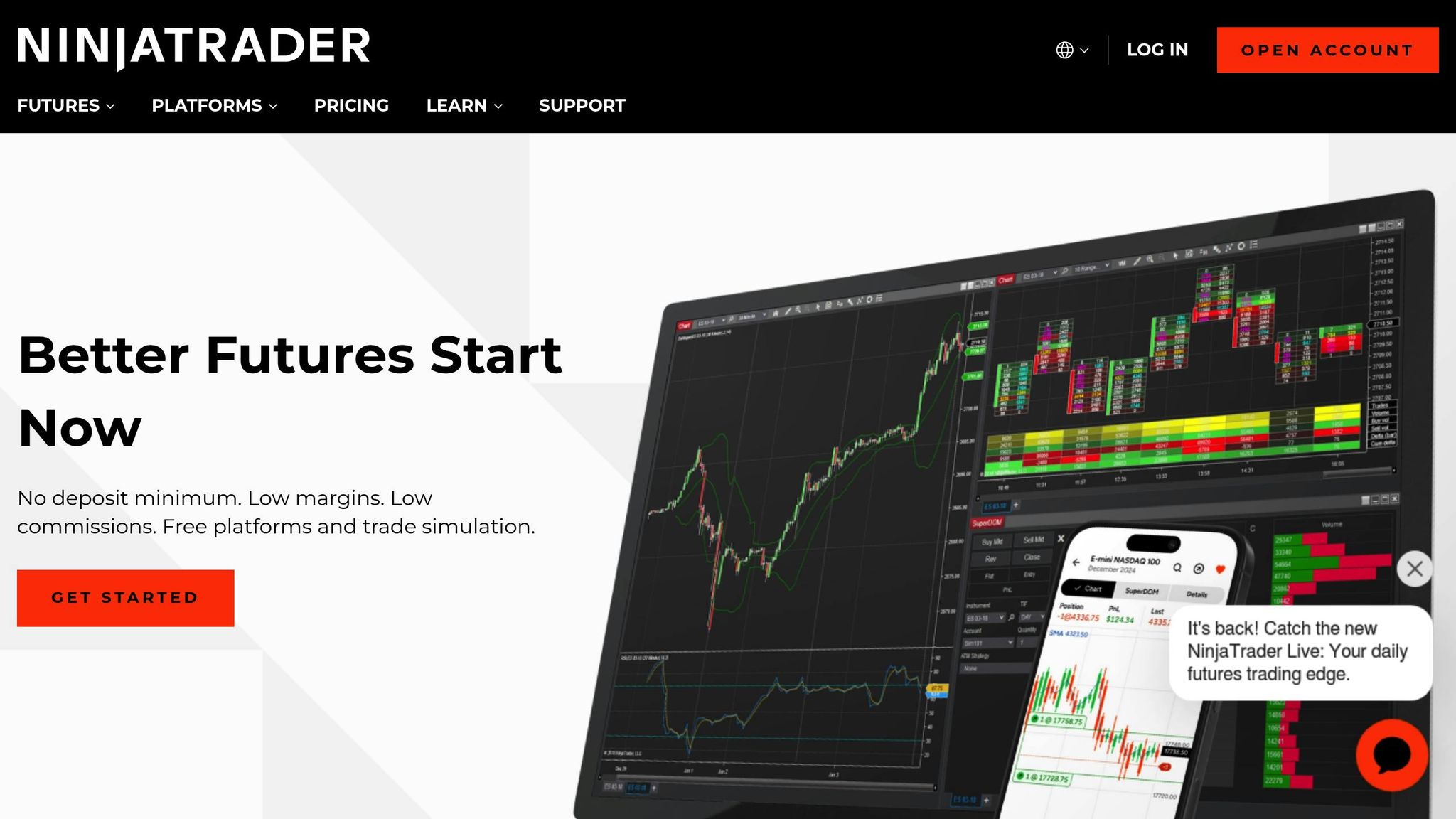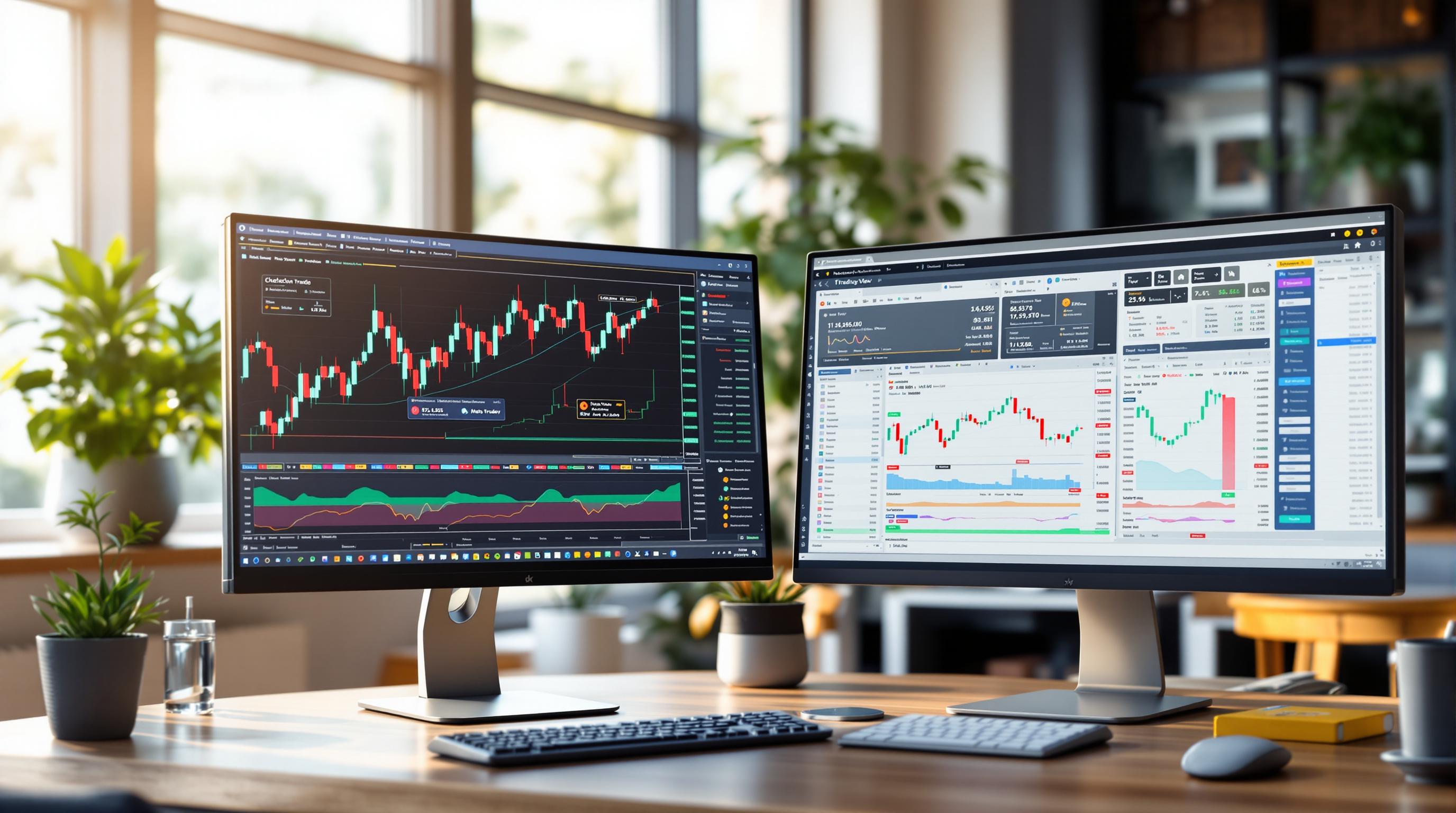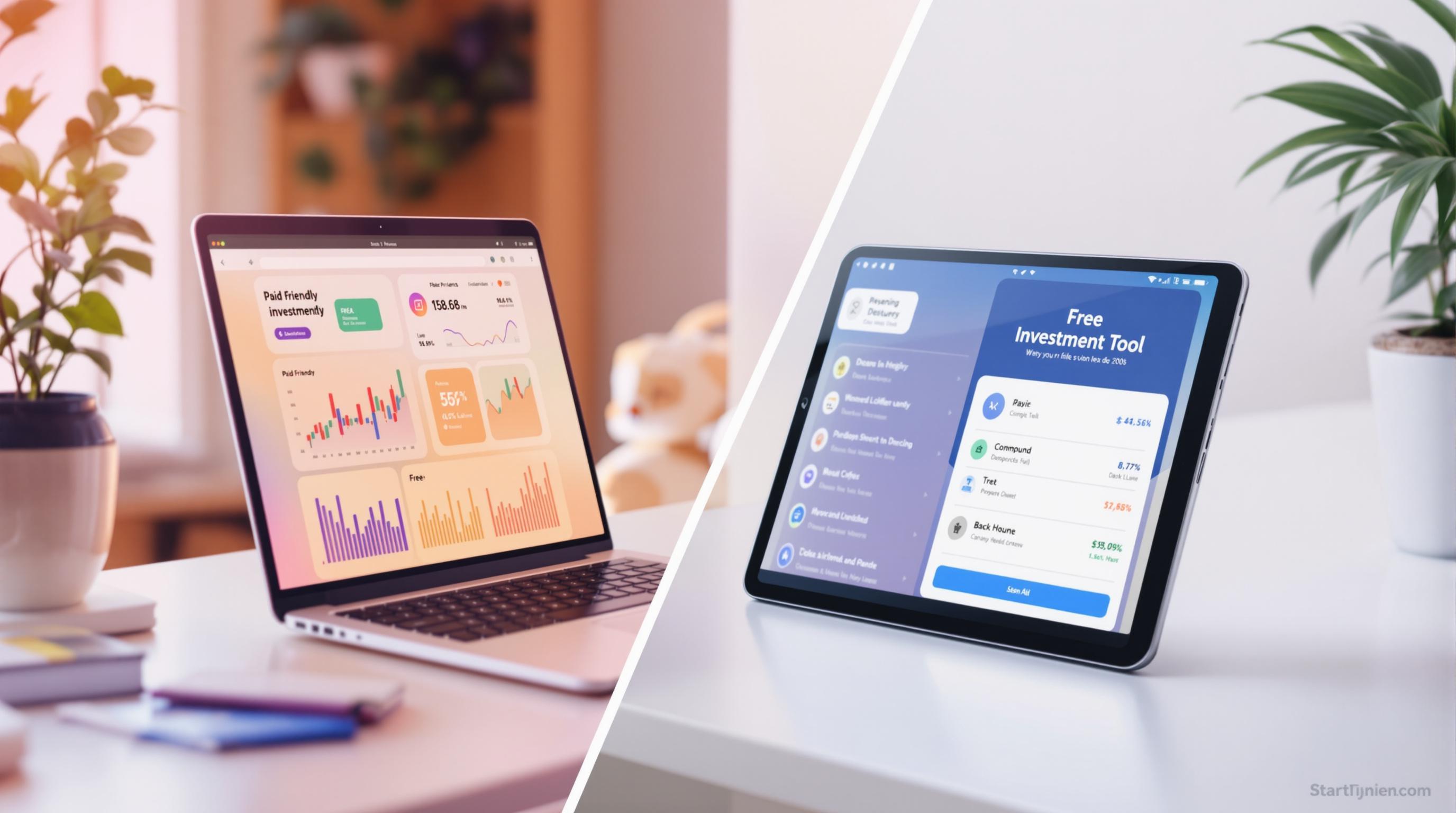TradingView and NinjaTrader are two leading platforms for traders, but they serve different needs:
- TradingView: Best for traders of all skill levels who value community insights, multi-asset analysis, and advanced charting tools. It's web-based, offers social features, and supports a wide range of markets.
- NinjaTrader: Designed for experienced traders focused on futures, forex, and automated strategies. It’s a desktop-based platform with advanced tools for execution and customization.
Quick Comparison:
| Feature | TradingView | NinjaTrader |
|---|---|---|
| Platform Type | Web-based, Desktop, Mobile | Desktop Software Only |
| Primary Focus | Multi-asset analysis & community | Futures & forex execution |
| Social Features | Extensive community features | Limited |
| Market Access | 2M+ instruments, 100+ exchanges | Focused on futures and forex |
| Programming Language | Pine Script (cloud-based) | NinjaScript (desktop-based) |
| Cost | Free to $49.95/month | Licensing and data fees apply |
Which to Choose?
- Go with TradingView if you want a versatile, social platform for multi-asset trading.
- Choose NinjaTrader if you're a futures or algorithmic trader needing advanced tools and automation.
Your decision should align with your trading style, skill level, and market focus.
Platform Basics
What is TradingView

TradingView is an online platform designed for market analysis and sharing trading ideas. With a global user base exceeding 100 million, it offers powerful charting tools paired with an active community of traders. Users have shared millions of custom scripts and trading concepts, making it a go-to platform for analyzing various asset classes.
What is NinjaTrader

NinjaTrader is a desktop application tailored for advanced trading in futures and forex markets. Known for its ability to handle complex operations and execute trades quickly, it caters primarily to experienced traders and those actively participating in the markets.
Here's a quick comparison of TradingView and NinjaTrader:
| Feature Category | TradingView | NinjaTrader |
|---|---|---|
| Platform Type | Web-based | Desktop-based |
| Primary Focus | Multi-asset analysis & social trading | Futures & forex execution |
| User Base | Over 100 million users | Professional traders |
| Key Strength | Accessibility & community features | Advanced execution & automation |
| Target User | All skill levels | Experienced traders |
Main Features Compared
Chart Analysis Tools
TradingView's Supercharts platform stands out with 400+ built-in indicators, access to 100,000+ community scripts, 110 drawing tools, and 15 chart types like Candles, Heikin Ashi, Renko, and Point & Figure. It also features Pine Script, a cloud-based programming language for creating custom indicators and strategies. Users can sync up to 16 charts per tab, making it a favorite for traders who value flexibility and customization.
NinjaTrader, on the other hand, focuses on futures and forex markets. It offers solid charting tools and uses NinjaScript for creating custom indicators and automating strategies.
But charting is just one part of the equation - market access is another area where these platforms differ.
Available Markets
TradingView connects to over 2 million instruments across 100+ global stock and futures exchanges, 50 brokerage feeds, 50 crypto exchanges, and 65 news providers. For U.S. traders, market bundles are priced at $9.95 for U.S. stocks, $7.00 for CME Group futures, and $2.00 for Eurex futures.
NinjaTrader, however, specializes in futures and forex markets, tailoring its market access to these specific asset classes.
Trading Automation
TradingView offers a range of automation tools, including cloud-based alerts with 13 built-in conditions, custom alerts via Pine Script, historical strategy testing, and the Pine Screener. Plus, its community has shared over 10 million custom scripts.
NinjaTrader also supports automation but focuses more on individual strategies rather than community-driven tools.
Social Features
TradingView creates a collaborative environment with its 100+ million users. The platform allows traders to share custom scripts, trading ideas, public indicators, and engage in collaborative learning. This social aspect makes it a hub for both beginners and experienced traders looking to exchange insights.
NinjaTrader, in contrast, prioritizes individual trading tools and offers limited social features.
| Feature | TradingView | NinjaTrader |
|---|---|---|
| Chart Types | 15+ (e.g., Candles, Renko, Point & Figure) | Standard technical charts |
| Built-in Indicators | 400+ built-in, access to 100,000+ community indicators | Basic package of technical indicators |
| Programming Language | Pine Script (cloud-based) | NinjaScript (desktop-based) |
| Market Access | Over 2 million instruments across multiple asset classes | Focused on futures and forex |
| Social Features | Extensive community features with 100+ million users | Limited social capabilities |
Platform Experience
Using TradingView
TradingView offers a user-friendly experience across web, desktop, and mobile platforms. Its interface is designed to handle multiple charts and data streams efficiently. With the Premium plan, users can access up to eight charts per layout and add up to 25 indicators per chart. Additional features include auto-restore, symbol syncing, crosshair synchronization, customizable tab titles, and multi-monitor support. The mobile app, rated 4.9 by over 1.5 million users, further adds to its popularity.
For complex analyses, the desktop version of TradingView generally performs better than its browser counterpart. However, heavy calculations can still affect performance. The platform also ensures smooth chart interactions during zooming, making technical analysis more seamless. These features highlight its adaptability to various trading approaches.
Using NinjaTrader
Unlike TradingView's focus on cross-platform accessibility, NinjaTrader is designed for a dedicated desktop experience, catering primarily to active futures and forex traders. Its desktop-centric setup provides a focused environment for serious trading.
Here’s a quick comparison of the user experience between TradingView and NinjaTrader:
| Experience Aspect | TradingView | NinjaTrader |
|---|---|---|
| Platform Type | Web-based, Desktop, Mobile | Desktop Software Only |
| Performance | Optimized desktop version | Exclusively desktop-based |
| Device Access | Cross-platform accessibility | Limited to installed computers |
| Interface Focus | Multi-asset class trading | Futures and forex specialization |
sbb-itb-2e26d5a
Cost Breakdown
TradingView Costs
TradingView provides a range of pricing options, starting with a free Basic plan and several paid tiers:
| Plan | Monthly Price | Annual Price | Key Features |
|---|---|---|---|
| Basic | Free | Free | Basic charting; 1 chart per layout |
| Essential | $12.95 | $155.40 | Ad-free; 2 charts per layout |
| Plus | $24.95 | $299.40 | 4 charts per layout; custom intervals |
| Premium | $49.95 | $599.40 | 8 charts per layout; priority support |
Additional costs may apply for sales tax depending on your location. If you need access to real-time or intraday data feeds, you'll need an active paid subscription or trial. Keep in mind that data feed charges are separate and vary by exchange.
NinjaTrader Costs
Unlike TradingView's tiered pricing, NinjaTrader uses a different pricing model. Specific details about NinjaTrader’s costs, including licensing, subscriptions, and data feeds, are not provided here. For accurate and up-to-date pricing, visit NinjaTrader’s official website.
When comparing these platforms, take into account not just the subscription costs but also data feed expenses, exchange connectivity fees, onboarding charges, any available annual discounts, and applicable taxes.
Tradingview vs Ninjatrader (2024): Which Is Better? Honest ...
Best Uses and Users
Now that we've covered costs, let's dive into which types of traders benefit most from each platform.
Who Should Use TradingView
TradingView is a go-to platform for traders who value community insights and robust charting tools. It's particularly well-suited for:
- Technical Analysis Fans: Perfect for traders who rely on charts and technical indicators. Beginners and intermediate traders can learn a lot from custom scripts and trading ideas shared by the community.
- Social Traders: Ideal for those who enjoy gaining insights from a community, sharing their own analysis, and engaging in discussions with peers.
- Multi-Asset Traders: Great for traders working across various markets and asset classes. Its web-based platform is flexible, and the mobile app has earned a stellar 4.9-star rating from over 1.5 million reviews.
On the other hand, NinjaTrader is better suited for traders with specific needs in advanced trading.
Who Should Use NinjaTrader
NinjaTrader caters to traders who require advanced tools and customization. It's best for:
- Professional Futures Traders: Designed for traders who need sophisticated order management tools and market depth analysis. Features like ATM and OCO orders are especially useful.
- Algorithm Developers: Ideal for traders creating automated strategies. If you're comfortable with C# programming and need solid backtesting tools, this platform delivers.
| Trading Style | TradingView | NinjaTrader |
|---|---|---|
| Primary Focus | Social trading & technical analysis | Futures & algorithmic trading |
| Skill Level | Beginner to Advanced | Intermediate to Expert |
| Best For | Chart analysis and social learning | Automation and custom strategies |
| Key Strength | Social features & accessibility | Advanced customization & automation |
Ultimately, your choice depends on your trading objectives, technical skills, and the type of assets you trade. TradingView shines with its community-driven approach and accessibility, while NinjaTrader is a powerhouse for automation and futures trading.
Conclusion
TradingView and NinjaTrader cater to different trading needs, each excelling in its own way. TradingView is a sleek, web-based platform known for its user-friendly design and active trading community. Its Pine Script feature makes it approachable for traders interested in technical analysis without needing extensive programming skills.
On the other hand, NinjaTrader is a powerful platform built for experienced, futures-focused, and algorithmic traders. It offers advanced tools, deep customization, and strong support for automated trading, making it a great option for those who need precision and control.
Which platform is right for you? That depends on your trading style and priorities:
-
TradingView works well if you:
- Prefer a web-based platform with easy navigation.
- Want access to a large library of technical indicators.
- Enjoy learning from and interacting with a trading community.
- Need flexibility in choosing brokerage integrations.
-
NinjaTrader is better if you:
- Primarily trade futures.
- Need advanced tools for managing orders.
- Plan to build and use automated trading systems.
For beginners, TradingView’s free-to-start model and simplicity are appealing. On the other hand, seasoned traders may gravitate toward NinjaTrader’s advanced automation and customization features.



